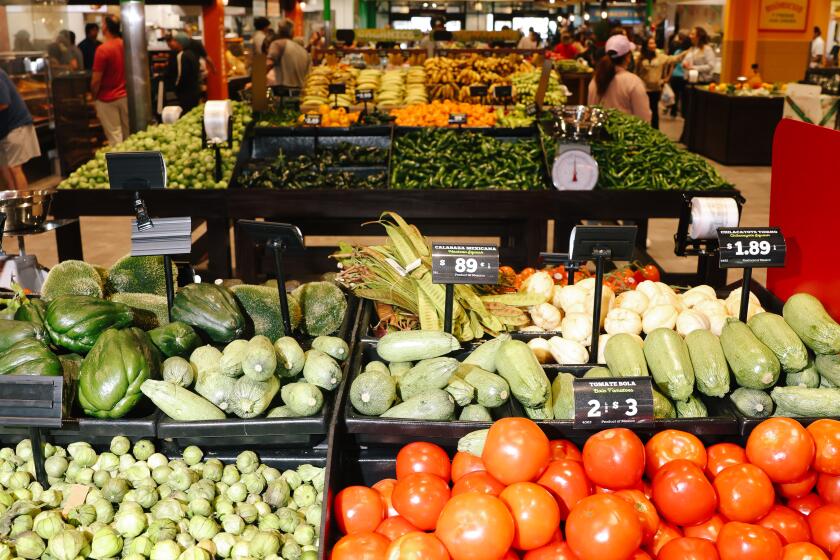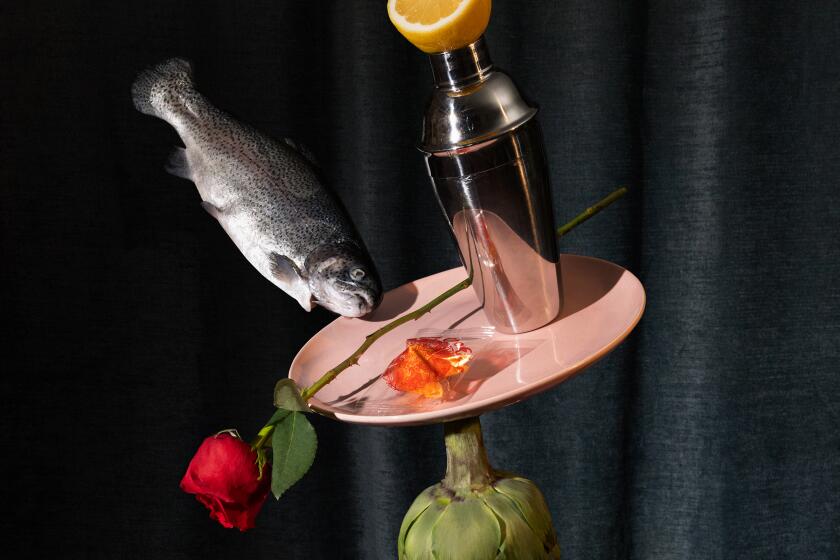3 Grills, Count ‘Em 3
Playwright Antonin Artaud noted that with every convenience and labor-saving device we embrace, a part of life is lost.
Our modern kitchens prove him right. With their high-tech ovens and microwaves, they have almost stripped us of the experience of fire. Perhaps that is why we grill.
The other reason is simply that grilled food tastes great. The smoke itself acts as a kind of flavoring--foods take the flavor of whatever kind of coals they are grilled over. Charcoal can lend a harsh, somewhat acrid flavor to food. I prefer to use hardwoods, which permeate foods with a sweet, complexly flavored smoke that is better than any marinade or enhancement.
Woods for grilling are becoming increasingly available. Mesquite, hickory and other hardwood chips are usually available in supermarkets, and fruit woods are often easy to find in back yards or can be purchased from orchard owners. (Resinous woods from evergreen trees are to be avoided.)
If it isn’t possible to grill entirely over hardwoods, a few chips or chunks that have been soaked in water for about a half hour (then shaken to remove excess water) can be added to a bed of white-hot charcoal, imparting their sweet smoke flavor to the foods.
Smoldering thyme or rosemary branches also impart an earthy scent. Simply feed the soaked and shaken sprigs, a few at a time, onto the coals to smoke as the food cooks.
The secret to great grilling is the marriage of the freshest seasonal ingredients with a well-prepared bed of coals. It takes about 40 minutes for a fire to burn down to coals, which should be glowing red in the center and covered with a layer of white ash, with no trace of flame.
The list of foods that take well to simple grilling is endless. Even fruits are delicious grilled. Peaches, apples, pears, apricots, pineapple and mango are particularly good, and can add unexpected and wonderful flavors to a meal, taking the place of a sauce or a condiment.
To grill fruit, halve or slice into pieces no more than one-inch thick. With the exception of pineapple, do not peel them. Brush the pieces lightly with olive oil or canola oil and grill cut-side down to start, turning once, until the fruit is soft but not mushy. Test for doneness after grilling three minutes to five minutes on each side. Grill bananas in their peel about five minutes on each side, until they are very soft. Then slice open the peel and scoop out the flesh.
To grill vegetables, it’s generally best to slice them between one-quarter- and one-half-inch thick. Or they can be wrapped in foil packages and nestled in the coals to cook. Poke the packages in several places with a skewer to let the smoke permeate the food. Cook 20 minutes to 35 minutes until the vegetables are soft. New potatoes, whole heads of garlic and chunks of root vegetables or winter squash are particularly delicious cooked this way.
If you are unable to grill directly over coals, the following recipes also work well for a broiler.
One of my favorite ways to grill whole white fish is to stuff it with herbs and wrap it with pancetta, the peppery unsmoked bacon from Italy. When grilled over a wood fire, the fish is moist and succulent, with a crisp skin. Because the pancetta bastes and protects the fish, there is less danger of overcooking. Other white-fleshed fish of similar size can replace the snapper.
GRILLED RED SNAPPER WITH PANCETTA AND HERBS
1 whole (about 2 1/2 pounds) red snapper, or 2 smaller (1 1/4 pounds each) fish, cleaned and scaled, head intact
1/2 teaspoon olive oil
3/4 teaspoon coarse salt
3/4 teaspoon freshly ground black pepper
8 bay leaves
4 sprigs fresh rosemary
1 1/2 ounces pancetta or bacon, cut into 4 thin slices
Rub fish all over with olive oil to taste. Season fish to taste inside and out with salt and pepper. Stuff 4 bay leaves and all rosemary sprigs into cavity of fish (2 bay leaves and 2 rosemary sprigs for each smaller fish).
Set fish flat on work surface and place 2 remaining bay leaves end to end along length of fish (1 each for smaller fish). Arrange 2 overlapping slices of pancetta on top of bay leaves across thickest part of fish, leaving tail and head exposed (use 1 slice of pancetta for each smaller fish). Hold pancetta in place with 1 hand and turn fish over. Repeat layering with remaining 2 bay leaves and pancetta slices. Tie several bands of kitchen string snugly around fish to secure bay leaves and pancetta.
Fish can be prepared to this point up to 4 hours before grilling. Cover with plastic wrap and refrigerate.
Preheat grill to hot, then place fish on lightly oiled grill rack, or sandwich fish between 2 oiled grids of grilling basket. Grill fish about 6 inches from heat 12 to 15 minutes per side for large fish, 8 to 10 minutes per side for smaller fish. Pancetta and fish skin should be crisp and browned but not charred, and fork inserted into thickest part of flesh should not meet with resistance until it hits bone. If either pancetta or skin begins to burn, move rack farther from heat source.
To serve, remove and discard string and bay leaves. Cut fish from bone and serve warm or at room temperature. Makes 4 servings.
This salad is a refreshing counterpoint to grilled meats and seafood. It pairs well with grilled bread that has been brushed with olive oil and rubbed with a cut garlic clove.
JICAMA, ORANGE AND GRILLED ONION SALAD
1 medium clove garlic, halved lengthwise
1 medium jicama, peeled
1 navel orange, zest removed and reserved, pith discarded
1/3 cup Nicoise olives
1 1/2 pounds sweet onions such as Maui or Vidalia, sliced 1/4-inch thick, keeping slices intact
1 tablespoon plus 1 teaspoon extra-virgin olive oil
1/2 teaspoon coarse salt
1 cup cilantro leaves
2 tablespoons lime juice
2 teaspoons balsamic or cider vinegar
Freshly ground pepper
Rub medium bowl with cut clove of garlic and discard. Quarter jicama through stem end and slice each quarter crosswise into 1-inch-thick slices. Place in prepared bowl. Slice orange zest into thin slivers. Quarter peeled orange lengthwise and slice each quarter crosswise into thin triangles. Add orange slices and zest to jicama.
If desired, pit olives, smack each with heavy can or meat pounder to split flesh and remove pits. Add olives to jicama-orange mixture.
Lightly brush onion slices with 2 teaspoons olive oil and arrange in oiled grill basket or place directly on grill. Sprinkle 1/4 teaspoon salt over slices and grill 5 to 8 minutes until onions just begin to blacken. Turn and grill until onions are tender and slightly charred, about 5 minutes longer. Separate into rings and add to jicama mixture.
Add cilantro, remaining 2 teaspoons olive oil, lime juice, vinegar, remaining 1/4 teaspoon salt and plenty of pepper. Toss to coat thoroughly. Makes 4 servings.
The traditional North African Berber mechoui is a whole lamb slowly spit-roasted as it is basted frequently with spiced butter. The meat is crisp on the outside, meltingly tender and sweet inside. This recipe parlays the traditional mechoui spices--garlic, cumin, coriander and paprika--into a highly unorthodox play on the original notion.
Half a leg of lamb is butterflied so the spiced paste penetrates the meat more completely, then it is grilled to medium-rare. This eliminates the need for the butter that the traditional slow-cooking method uses.
MODERN MECHOUI
1 tablespoon plus 1/4 teaspoon coriander seeds
2 teaspoons cumin seeds
2 teaspoons imported sweet paprika
1/2 teaspoon salt
1/4 teaspoon sugar
5 to 6 cloves garlic, coarsely chopped
1 tablespoon plus 1 teaspoon olive oil
2 tablespoons water
1/2 leg of lamb from shank end (about 3 1/2 pounds), butterflied and trimmed of fat
Toast coriander and cumin seeds in small skillet until fragrant, about 2 minutes. Transfer to blender along with paprika, salt and sugar and grind at high speed until spices are reduced to powder. Add garlic, 1 tablespoon olive oil and water and blend to thick paste.
Rub spice paste on both sides of lamb. Place on platter, cover with plastic wrap and refrigerate overnight or up to 24 hours.
Blot lamb dry with paper towels without wiping off all spices. Rub remaining 1 teaspoon olive oil into lamb. Grill lamb on oiled rack over hot coals or in broiler about 10 minutes on each side for medium-rare, or until meat thermometer inserted in fleshiest part reads 140 degrees.
Let lamb stand 10 to 15 minutes before carving. Carve in wide diagonal slices across grain. Makes 6 to 8 servings.
Schneider is the author of “The Art of Low-Calorie Cooking” (Stewart, Tabori & Chang).
More to Read
Eat your way across L.A.
Get our weekly Tasting Notes newsletter for reviews, news and more.
You may occasionally receive promotional content from the Los Angeles Times.






